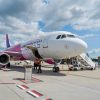 Accounting for around 5% of the global aircraft fleet, the Middle East seems to be the place where most aviation industry players should be on cloud nine. However, most countries within the region are far from ready to handle the ever-growing demand. In fact, over the next several decades the Gulf is expected to require a staggering 90 700 of aviation personnel, including pilots, cabin crew and technicians.
Accounting for around 5% of the global aircraft fleet, the Middle East seems to be the place where most aviation industry players should be on cloud nine. However, most countries within the region are far from ready to handle the ever-growing demand. In fact, over the next several decades the Gulf is expected to require a staggering 90 700 of aviation personnel, including pilots, cabin crew and technicians.
One thing is clear: meeting such a demand by relying on local workforce alone is anything but realistic. Moreover, the current aviation training infrastructure is still insufficient to even consider such a possibility, at least in the upcoming decade or so. The only available solution is to seek ways to attract expat employees who, following the recent economic crisis in the West, are fortunately (if only for the potential employers) still on the market.
For instance, Germany currently has 696 aircraft in their fleet, which means that there are 115 000 Germans for each aircraft. In comparison, the UAE with 9 million citizens is home to 470 aircraft, which means that there are only 19 000 people for each aircraft. In other words, the UAE has almost 10 times less talent to choose from and train in handling every new aircraft. Therefore, the reliance on expat workforce truly makes sense.
According to the Alpen Capital group GCC 2014 Aviation sector report, the UAE, Qatar, Bahrain and Kuwait employ over 60% expatriate aviation workforce with only Saudi Arabia and Oman relying more on the local labour pool, rather than outsourcing their workforce. Although aviation is supposed to be the industry with no borders, it is no exception when it comes to issues related to cultural differences. For instance, Qatar Airways, the world’s 10th largest air carrier, has recently announced its new rules for flight attendants, requiring female crew members to be single when hired and remain that way for five years. The same air carrier came under fire last year when it publically suggested women to wear short skirts on cabin crew recruitment day. Needless to say, these and other controversial challenges are amongst the reasons behind the lack of qualified workforce in the Middle East.
Local players are well aware of the HR-related challenges and it would be wrong to say that nothing is done to address them. The Emirates flight academy says it will be able to  facilitate access to 40 000 new pilots in the Middle East over the following two decades. However, despite the fact that the existing training facilities are highly promising, catching up with the aforementioned growth is out of the question any time soon. For instance, training center in UAE has an average of 1600 full and part-time students per year and Jordan-based school is producing 130 licensed professionals every year but all these facilities combined with the recent news about Emirates-CAE Flight Training expanding their number educational bays from 5 to 10 still is not quite sufficient.
facilitate access to 40 000 new pilots in the Middle East over the following two decades. However, despite the fact that the existing training facilities are highly promising, catching up with the aforementioned growth is out of the question any time soon. For instance, training center in UAE has an average of 1600 full and part-time students per year and Jordan-based school is producing 130 licensed professionals every year but all these facilities combined with the recent news about Emirates-CAE Flight Training expanding their number educational bays from 5 to 10 still is not quite sufficient.
“Many experts stress the difference in customs and culture, but it is not the main reason for this staggering demand. Up-skilling the local workforce may well provide tangible long-term results in the region’s headhunting challenge. However, one should keep in mind that aviation currently supports over 250 000 people in Dubai alone. Just to get a grips of these benefits, these workers represent almost 20% of total Dubai employment and contribute 28% of countries’ GDP” – says Skaiste Knyzaite, the CEO of AviationCV.com. With the sheer scale of demand expected in the upcoming years within the region, employers are forced to consider the position they have their eyes set upon. Airlines should already re-think their strategies when it comes to grabbing the best talent out there.
Currently the world is witnessing the soaring demand in qualified personnel across the GCC countries. Obviously, one’s head instantly races to the issue of training & development. “All the combined facilities in the Gulf can currently produce 1750 aviation workers per year, however, it is not nearly enough to reach 2000 specialists in demand forecasted by the industry specialists. In fact, these figures are not really portraying the actual case. The genuine issue here is the lack of experienced and certified personnel. Developing specialists with none or just some experience in the field combined with cultural diversity of the region is the challenge to overcome. That is why you need a huge HR pool to discover not only a reliable certified professional but also one that meets culture and values of both – country and business,” concludes Skaiste Knyzaite, the CEO of AviationCV.com.





